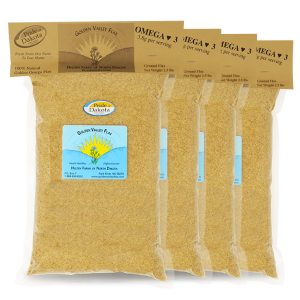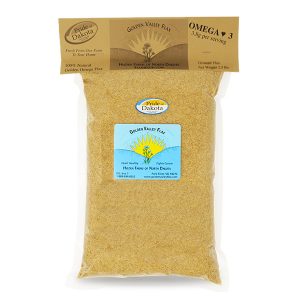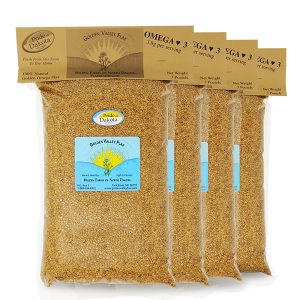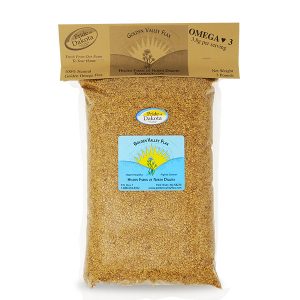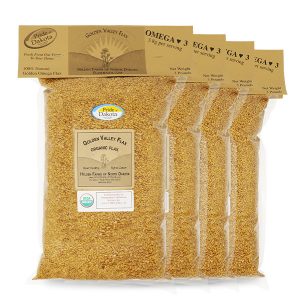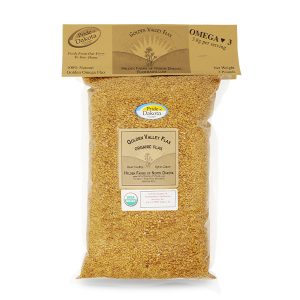Omega-3 Fatty Acid Family

Alpha-linolenic acid (ALA)* is the parent compound of the omega-3 fatty acid family. ALA is a precursor to the long-chain fatty acids eicosapentaenoic acid (EPA) and docosahexaenoic acid (DHA) and is an essential fatty acid for humans because it cannot be synthesized from dietary precursors.
What Is the Availability of Omega-3 Fatty Acids in the Diet?
Omega-3 fatty acids constituted a minuscule portion (<1%) of the total fatty acids in the U.S. food supply in 1985, whereas the omega-6 fatty acids constituted a significant majority. Thus, the level of omega-3 fatty acids in the U.S. food supply is low relative to the omega-6 fatty acid level.[1]
This fatty acid imbalance has led some nutrition experts to recommend replacing some omega-6 fatty acids in the diet with those of the omega-3 family.[2] Concern about the current high level of omega-6 fatty acids in the food supply arises from studies of their health effects in humans. Omega-6 fatty acids interfere with the conversion of ALA to its long-chain metabolites, EPA and DHA; and one omega-6 fatty acid, arachidonic acid, is converted to thromboxane A2 and other eicosanoids that tend to enhance atherosclerosis by promoting vasoconstriction and platelet aggregation. In contrast, the omega-3 fatty acids inhibit the conversion of linoleic acid to arachidonic acid, thereby reducing the biosynthesis of arachidonic acid and its eicosanoids.[3], [4] Omega-3 fatty acids appear to provide protection against atherosclerosis, cardiac arrhythmias, hypertension, inflammatory and autoimmune disorders, and some types of cancer.[2], [5], [6] ALA may have particular antithrombotic properties that reduce the risk of fatal cardiovascular events and stroke.[7], [8]
Food Sources
What are the Major Food Sources of ALA?
Up to 80% of the fatty acids in leafy green plants is in the form of ALA; but because their overall lipid content is low, leafy plants do not contribute significant amounts of ALA to our diets.[9] Flaxseed is by far the richest source of ALA[1] ALA is also found mainly in the fats and oils of canola, wheat germ and soybeans; in nuts such as butternuts and walnuts; and in red and black currant seeds.[10] Fish contain only trace amounts of ALA, although some species of fish, particularly fatty marine fish such as salmon, mackerel and herring, are rich in EPA and DHA.[11]
What Are the Food Industry Uses of Flaxseed?
Surveys show that North American consumers want foods with a strong sensory appeal and healthful image. They perceive a need to improve their diets and believe they could be doing more to ensure proper nutrition. Canadian consumers, for example, are generally concerned about the fat content of foods and worry whether their fibre intake is adequate.[12] The food industry, particularly the baking industry, is turning to flaxseed to meet consumers’ demand for foods that taste good and provide nutritional and health benefits. Bakers are adding milled flaxseed to so-called hearth breads — breads baked in open hearths and not in pans — and to variety or multigrain breads. In multigrain breads, flaxseed is mixed with three or more other grains. Milled flaxseed is also added to mixes, frozen doughs and thaw-and-serve food products. These products are designed to meet the North American consumers’ demand for convenience and ease of preparation.[13] Overall, flaxseed is a traditional food whose nutritional profile and good taste is capturing the attention of the food industry.
How Can Consumers Increase Their ALA Intake?
Consumers can increase their ALA intake by adding flaxseed to homemade baked goods; sprinkling flaxseed on yogurt, cereal and salad; purchasing flaxseed breads and muffins at retail stores; and buying omega-3 enriched eggs. The increased ALA content of omega-3 enriched eggs is achieved by feeding hens rations containing flaxseed. These eggs, which contain about 0.40 g omega-3 fatty acids per large egg, provide roughly 7-12 times more omega-3 fatty acids than regular eggs. One omega-3 enriched egg provides nearly half of the optimal intake level of ALA and about one-quarter of the optimal intake level of EPA and DHA — all together about the same amount of omega-3 fatty acids found in a 3 oz. serving of fish.[14] Consumption of omega-3 fatty acids from eggs has been reported to reduce serum lipids and blood pressure in humans.[15], [16]
Flaxseed Uses in Baking
Consumers can easily add flaxseed to their favourite yeast and quick breads. Reddish-brown flaxseeds (which are slightly larger than sesame seeds) can be bought whole or milled at many bulk food retail stores. Whole seeds can be stored at room temperature for up to one year. The seeds can be milled in a clean coffee grinder to a granular, free-flowing meal. Milled flaxseed should be placed in an airtight, opaque container and either refrigerated or frozen. Refrigerated milled flaxseed should be used within 30 days.
For baking purposes, milled flaxseed can be substituted for the fat used in baking at a ratio of 3 to 1. For example, 1 1/2 cups of milled flaxseed can replace 1/2 cup of butter, margarine, shortening or cooking oil in a traditional recipe. Because baked goods made with flaxseed brown rapidly, suggested cooking times should be followed carefully.[17] Flaxseed can be sprinkled on top of yeast or quick breads prior to baking for added taste and crunch.
References
- Raper NR, et al. The Journal of the American College of Nutrition. 1992; 11: 304-308.
- Simopoulos AP. The American Journal of Clinical Nutrition. 1991; 54: 438-463.
- Leaf A and Weber PC. The New England Journal of Medicine. 1988; 318: 549-557.
- Dupont J, et al. The American Journal of Clinical Nutrition. 1996; 63: 991S-993S.
- Nair SSD, et al. Journal of Nutrition. 1997; 127: 383-393.
- Emken EA. In: Proceedings from the Scientific Conference on Omega-3 Fatty Acids in Nutrition, Vascular Biology, and Medicine. Dallas, TX: American Heart Association, 1995, pp. 9-18.
- de Lorgeril M, et al. Lancet. 1994; 343: 1454-1459.
- Simon JA, et al. Stroke. 1995; 26: 778-782.
- Cunnane SC. In: Flaxseed in Human Nutrition. Cunnane SC and Thompson LU, eds. Champaign, IL: AOCS Press, 1995, pp. 99-127.
- Nettleton JA. Journal of the American Dietetic Association. 1991; 91: 331-337.
- Nutrient Data Research Branch, Nutrition Monitoring Division. Provisional Table on the Content of Omega-3 Fatty Acids and Other Fat Components in Selected Foods (100 GramsEdible Portion, Raw). Beltsville, MD: U.S. Department of Agriculture, 1988.
- Beggs L, et al. Journal of the Canadian Dietetic Association. 1993; 54: 21-25.
- Payne TJ. In: Flax Council of Canada Conference Proceedings. Winnipeg, MB: Flax Council of Canada, 1997, pp. 50-64.
- Sim JS and Qi G-H. In: Flaxseed in Human Nutrition. Cunnane SC and Thompson LU, eds. Champaign, IL: AOCS Press, 1995, pp. 315-333.
- Oh SY, et al. The American Journal of Clinical Nutrition. 1991; 54: 689-695.
- Cunnane SC, et al. The American Journal of Clinical Nutrition. 1994; 61: 62-68.
- Anon. Adding milled flax to your quick breads. Flax Focus. 1996; 9: 4.
Flax Council of Canada, 465–167 Lombard Ave., Winnipeg, MB, Canada R3B 0T6
E-mail: flax@flaxcouncil.ca
Web site: www.flaxcouncil.ca
Republished with permission.
Related Flax Articles
- (Flaxseed) Storage and Baking Stability
- Nutritional Components of Flax
- High Intakes of Alpha Linolenic Acid (ALA) Reduce Risk of Cardiovascular Diseases
- The Importance of Omega-3 Fatty Acids for Adults and Infants

